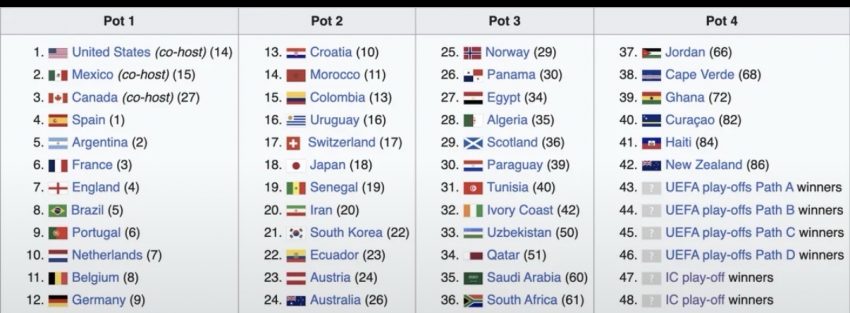The anticipation for the 2026 FIFA World Cup, hosted across the United States, Mexico, and Canada, continues to grow. One of the most important milestones ahead of the tournament is the draw, which determines the group stage matchups. FIFA has officially released the seedings, dividing all 48 teams into four pots based on rankings and host status. These pots will shape the path to glory for every nation.
Below is an SEO-friendly guide to the confirmed 2026 World Cup draw pots, how the teams are seeded, and what to expect next.
⸻
Pot 1: Hosts and Global Powerhouses
Pot 1 features the three host nations—United States, Mexico, and Canada—alongside the highest-ranked teams in the world. These nations will head their groups and avoid each other in the early stages.
Pot 1 Teams:
- United States (co-host)
- Mexico (co-host)
- Canada (co-host)
- Spain
- Argentina
- France
- England
- Brazil
- Portugal
- Netherlands
- Belgium
- Germany
These nations include former World Cup champions like Brazil, Germany, Argentina, France, and Spain, making Pot 1 the most elite tier in the competition.
⸻
Pot 2: Strong Contenders and Dark Horses
Pot 2 contains formidable teams capable of deep tournament runs. Many of these nations have a history of knockout-stage success and could easily challenge for the title.
Pot 2 Teams:
- Croatia
- Morocco
- Colombia
- Uruguay
- Switzerland
- Japan
- Senegal
- Iran
- South Korea
- Ecuador
- Austria
- Australia
Teams like Croatia (2022 semifinalists), Morocco (2022 semifinalist), and Uruguay bring tactical depth and tournament experience, making Pot 2 one of the most competitive.
⸻
Pot 3: Rising Nations and World Cup Regulars
Pot 3 combines growing football nations with traditional World Cup participants. These teams will be looking to secure spots in the knockout rounds and potentially deliver major upsets.
Pot 3 Teams:
- Norway
- Panama
- Egypt
- Algeria
- Scotland
- Paraguay
- Tunisia
- Ivory Coast
- Uzbekistan
- Qatar
- Saudi Arabia
- South Africa
This pot features successful African teams like Ivory Coast and Algeria, Middle Eastern strongholds like Qatar and Saudi Arabia, and European hopefuls Norway and Scotland.
⸻
Pot 4: Playoff Winners, Underdogs, and Debutants
Pot 4 includes lower-ranked nations, potential debutants, and playoff winners still awaiting qualification. This pot often produces the biggest surprises.
Pot 4 Teams:
- Jordan
- Cape Verde
- Ghana
- Curaçao
- Haiti
- New Zealand
- UEFA Path A winner
- UEFA Path B winner
- UEFA Path C winner
- UEFA Path D winner
- Intercontinental Playoff winner 1
- Intercontinental Playoff winner 2
Ghana, Cape Verde, New Zealand, and Haiti bring unique styles and tournament experience. The final places will come from European and intercontinental playoffs.
⸻
What Happens Next?
- Final playoff paths will determine the remaining spots in Pot 4.
- The official World Cup draw is expected in late 2025, when groups will be finalized.
- With 48 teams, the tournament will have 12 groups of four teams, expanding global participation and opportunities.
⸻
Why the Draw Matters
This is the first World Cup featuring 48 teams, making it the largest edition in history. The draw will determine group dynamics, potential “Groups of Death,” and early high-profile matchups such as England vs Germany or Argentina vs Japan.


